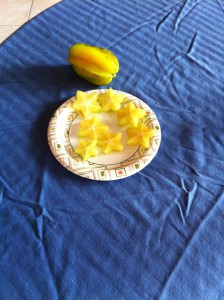This area of South Florida has a fascinating history when it comes to agriculture. I’ve written several posts about different aspects of it and as a reminder, we have two rather distinct growing seasons. Winter crops are produce such as tomatoes, corn, strawberries that look like rubies, pole beans, and more, but when the temperature rises, it’s time for the tropical fruits.
I never knew there were as many varieties of avocado (ever seen a purple one?) as we have here. I am not a big fan of papaya and mango except in small quantities and I have only recently come to enjoy carambola, more commonly known as star fruit because of its shape when sliced.
In fact, when you look at a whole fruit, you won’t necessarily know what to do with it. The skin in very thin and unless it has started to discolor, I just slice the fruit with the skin on. Since the “ridges” begin to brown first, its easy to trim the browned edges off. The thing about carambola though is that it varies in the degree of sweetness and the color from pale green to yellow. In my limited experience, the pale green tends to be tart. There are tiny seeds that can be poked out as you slice the fruit. I find the taste to be similar to a kiwi. As you can see from the photo, carambola also makes a lovely display. Lastly, the unique Schnebly Redland Winery and Brewery (http://www.schneblywinery.com/) uses it for one of their wines and it makes a great base as a tropical sangria. So, the next time you see a piece of “star fruit” on a plate, give it a try.


